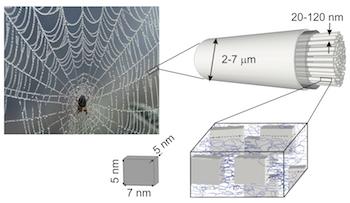Spiders Inspire Stronger Materials That Manipulate Sound, Heat
Researchers are taking inspiration from how spider silk transmits sound to inspire stronger materials that manipulate both sound and heat.
August 2, 2016
Spider webs aren’t thought of as particularly noisy things, but they do transmit sound and researchers are using the way they do it to inspire new and stronger materials that manipulate both sound and heat in the same way that semiconductors manipulate electrons.
Researchers at Rice University in conjunction with engineers in Europe and Singapore have discovered that spider silk has a phonon band gap. Phonons are quanta of vibrational mechanical energy, or sound. The finding means the silk can block phonon waves in certain frequencies in the same way an electronic band gap -- which is the basic element of semiconducting materials -- allows some electrons to pass and stops others.
The team, including materials scientist and Rice Engineering Dean Edwin Thomas, has investigated how the crystalline microstructure of spider silk might be replicated in other polymers. This could allow for tunable, dynamic metamaterials like phonon waveguides and novel sound or thermal insulation, since heat propagates through solids via phonons, he said.

Scientists at Rice University and in Europe and Singapore studied the microstructure of spider silk to see how it transmits phonons, quanta of sound that also have thermal properties. They suggested what they learned could be useful to create strong synthetic fibers with silk-like properties.
(Source: Dirk Schneider, Rice University)
“Phonons are mechanical waves,” Thomas said, “and if a material has regions of different elastic modulus and density, then the waves sense that and do what waves do: they scatter. The details of the scattering depend on the arrangement and mechanical couplings of the different regions within the material that they’re scattering from.”
Spiders use vibrations in their web expertly, using them to locate defects and to know when insects that may become their food approach and get caught up in the web. In the same way, spider silk has the ability to transmit a wide range of sounds that scientists think the arachnid can interpret in various ways while also having the ability to dampen some sound.
The most recent research on the potential for phonon manipulation has its roots in work Thomas and George Fytas, a materials scientist at the University of Crete in Greece, conducted in 2005. At the time, the researchers worked on a project to define the properties of hypersonic phononic crystals, measuring phonon propagation and detecting band gaps in synthetic polymer crystals aligned at regular intervals.
Back then they discovered that phononic crystals provide the ability to manipulate sound waves, and if the sound is small enough and at a high enough frequency, there also is heat involved, Thomas said. “Being able to make heat flow this way and not that way, or make it so it can’t flow at all, means you’re turning a material into a thermal insulator that wasn’t one before,” he said.
Based on this work, the two turned their attention to dragline silk, which spiders use to build the outer rim of their webs and also as a lifeline. The hierarchical structure of the material is comprised of a protein that folds into sheets and forms crystals interconnected by softer chains, Thomas said. The silk’s acoustic properties can be changed by stretching or relaxing those chains, which adjusts the mechanical coupling between the crystals.
READ MORE ARTICLES ON BIOMIMICRY:
Further work by Fytas’ team at the Max Planck Institute for Polymer Research in Mainz, Germany; researchers at Rice; and other scientists in Europe and Singapore continued to study the microstructure of spider silk to see how it transmits phonons, observing for the first time a “hypersonic phononic band gap in a biological material, Thomas said. Their findings could be useful to the development of strong synthetic fibers with silk-like properties and other applications, Thomas said.
“Right now, we don’t know how to do any of this in other macromolecular fiber materials,” Thomas said. “There’s been a fair amount of investigation on synthetic polymers like nylon, but nobody’s ever found a band gap.”
The team published a paper on their findings and its implications in the journal, Nature Materials.
Elizabeth Montalbano is a freelance writer who has written about technology and culture for more than 15 years. She has lived and worked as a professional journalist in Phoenix, San Francisco, and New York City. In her free time she enjoys surfing, traveling, music, yoga, and cooking. She currently resides in a village on the southwest coast of Portugal.
About the Author(s)
You May Also Like
.jpg?width=300&auto=webp&quality=80&disable=upscale)


